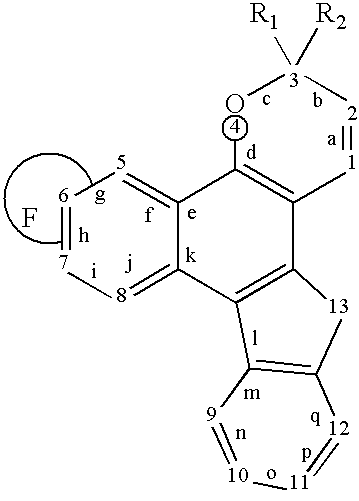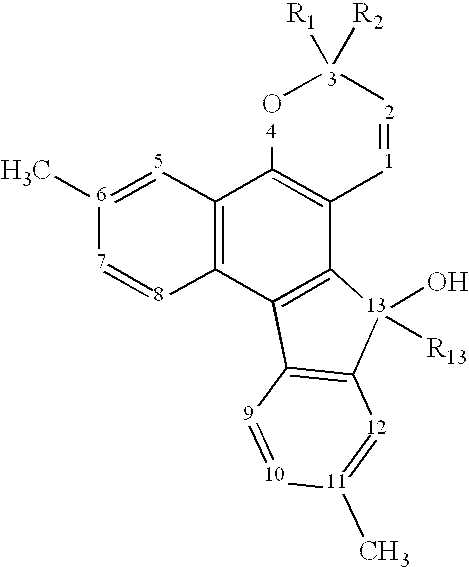Photochromic naphthopyran compounds: compositions and articles containing those naphthopyran compounds
a technology of naphthopyran and composition, applied in the field of photochromic naphthopyran compounds, can solve the problems that none of the compounds described to date have the complete combination of properties necessary for the production of satisfactory articles, and achieve the effect of high sensitivity to solar radiation
- Summary
- Abstract
- Description
- Claims
- Application Information
AI Technical Summary
Benefits of technology
Problems solved by technology
Method used
Image
Examples
example 1
[0151]Step 1: To a reaction flask containing 2,3-dihydrobenzofuran (13.5 grams) and benzoyl chloride (16.6 grams) in 170 milliliters (mL) of methylene chloride were added anhydrous aluminum chloride (18.0 grams) under nitrogen blanket over 40 minutes. The reaction temperature was controlled at around 25° C. with an ice / water bath. The reaction mixture was stirred at room temperature overnight. The resulting mixture was poured into 150 mL of ice / water and stirred vigorously for 30 minutes. The organic layer was separated, washed with water, dried over magnesium sulfate. The methylene chloride solvent was removed by rotary evaporation to give 25 grams of thick pink oil. It is used ‘as is’ in the next step.
[0152]Step 2: The product from Step 1 (25 g), dimethyl succinate (21.0 g), and potassium t-butoxide (16.5 g) were mixed in 250 ml of toluene. The mixture was refluxed for 2 hours under nitrogen blanket. After it was cooled to room temperature, 200 ml of water was added and mixed well...
example 2
[0158]3,3-di(4-methoxyphenyl)-13-methyl-13-hydroxy-3H-(4,5-dihydrofurano[2,3-b]-indeno[3,2-f]-naphtho)[1,2-b]pyran was obtained by following the process of Example 1, replacing 1-(4-methoxyphenyl)-1-phenyl-2-propyn-1-ol with 1,1-di(4-methoxyphenyl)-2-propyn-1-ol in Step 6, and replacing phenyl magnesium bromide with methyl magnesium iodide in Step 7. The structure was confirmed by a NMR spectrum.
example 3
[0159]3,3-di(4-methoxyphenyl)-13-ethyl-13-hydroxy-3H-(4,5-dihydrofurano[2,3-b]-indeno[3,2-f]-naphtho)[1,2-b]pyran was obtained by following the process of Example 1, replacing 1-(4-methoxyphenyl)-1-phenyl-2-propyn-1-ol with 1,1-di(4-methoxyphenyl)-2-propyn-1-ol in Step 6, and replacing phenyl magnesium bromide with ethyl magnesium bromide in Step 7. The structure was confirmed by a NMR spectrum.
PUM
 Login to View More
Login to View More Abstract
Description
Claims
Application Information
 Login to View More
Login to View More - R&D
- Intellectual Property
- Life Sciences
- Materials
- Tech Scout
- Unparalleled Data Quality
- Higher Quality Content
- 60% Fewer Hallucinations
Browse by: Latest US Patents, China's latest patents, Technical Efficacy Thesaurus, Application Domain, Technology Topic, Popular Technical Reports.
© 2025 PatSnap. All rights reserved.Legal|Privacy policy|Modern Slavery Act Transparency Statement|Sitemap|About US| Contact US: help@patsnap.com



